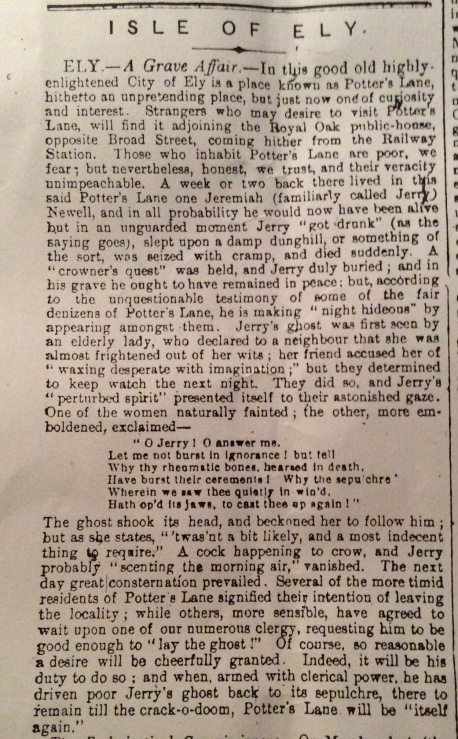Whilst helping my father to clear out my uncle’s house in Little Downham last year, i found absolutely tons of photos, but amongst them were many that had belonged to their neighbour (and my grandmother’s best friend) Mrs Vera Buttress, who wrote her name on the reverse of each one – including this one.

I love this photo – an elderly couple getting married in 1914 – and so I kept hold of it.
Today I finally decided that I would spend a few minutes to see if I could identify ‘Mr and Mrs Symons’ in records. No. No such marriage.
This frustrated me somewhat, as having a photograph, turning it into a postcard, and printing these would not have been ever-so cheap in 1914. So it felt unlikely to have been staged for the April Fool Day date written on the front.
The photographer clue
The photo is a postcard by Starr and Rignall – well known photographers of Ely, so i checked for a marriage on 1st April 1914 in Cambridgeshire, with a load of variants.
It was FindMyPast that turned up the answer, and unsurprisingly I found them in Little Downham, hence why Mrs Buttress had it. I turned to my transcription of the parish records.
The bridegroom is given as Robert Symonds, 75yrs, widower, otp, son of Robert Symonds, lab. The bride is named as Mary Howlett, 84yrs, widower, daughter of George Bonnett, labourer. The witnesses were George Lythell and Eliza Ann Lythell.
Now, this became much more interesting – the Lythell surname is a local surname (and I have many in my family tree), but more tantalising is that I have two Howlett to Bonnett marriages in my tree already.
I then tried to find Mary on the 1911 census from 3yrs earlier. There was nothing that stood out as even mildly correct.
I decided to turn to the other end of their lives and see when the couple died – and so I checked Downham’s cemetery records. This gave me Robert as being buried in grave L20 on 6th April 1918, aged 80, just days after their 4th Wedding Anniversary.
I couldn’t find a Mary (apart from one in 1908, presumably Robert’s previous wife). Instead, there’s an Elizabeth Symonds buried there on 10th Dec 1920 in grave L77.
This was both puzzling and exciting – in that whilst it’s not the Mary I was expecting, if this means she was really Elizabeth, then that would very likely place her in my tree as the Elizabeth Bonnett, daughter of George Bonnett (and also matching the wedding register) who married my relative James Howlett at Mildenhall, Suffolk in 1859.
Scene at Little Downham
With this being a wedding of a couple of older people, I wondered whether the newspapers might have picked up on it, and sure enough they had:

The article confirms the Lythells, the studio photograph, but once again refers to the bride as ‘Mary’.
Amusingly it also refers to their first ride in a motorcar.
The Honeymoon
Out of curiosity, I wondered whether this grand occasion might have appeared in any of the Cambridgeshire photographic books I’ve bought over the years. A quick flick-through the first one I grabbed from my collection, led me to this:

This shows the couple again – clearly matched by their faces, and in a car as corroborated by the newspaper article, but here in The Archive Photographs Series: Ely (Chalford, 1997) they’re erroneously captioned with “A Little Downham couple outside the Minster Restaurant and Cafe on 1 April 1914. This photograph was taken after their wedding, a second one in each case; Mr Lythell was eighty-four and his wife seventy-eight“.
The ages and surname are incorrect (with Lythell interestingly being borrowed from the witnesses and best-man), but the rest of the detail matches, and even the style of ‘On the honeymoon’ writing matches that of the other photograph from my collection. I don’t have the original photograph of this, but I bet it too is a Starr & Rignall postcard.
So, the final piece of this jigsaw will be finding ‘Elizabeth’/’Mary’ in her first marriage to my relative James Howlett, and seeing whether between 1859 and his death (a date I don’t yet know), she uses one or either names, and that he has died by 1914.
Even if she proves to be someone different all together, I’ve enjoyed unravelling the clues, and sharing the happy couple’s day, more than 104yrs later.
My grandmother is highly unlikely to have borrowed this from her friend Vera because she knew that it was a relative – the ‘Mary’ shown in the photo would have been her great grandfather’s sister-in-law. I think it’s purely coincidence.
The reason I got this photograph out today was to collect up all these old photos that once belonged to Vera Buttress, and to organise a ‘handing over’ of them to their village history society… but it pays to just have a thorough look through such things because you don’t know what you might unravel with a little bit of research.



















